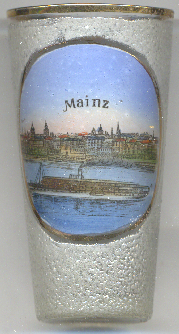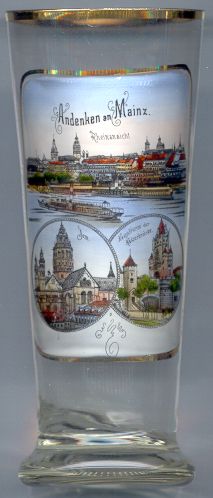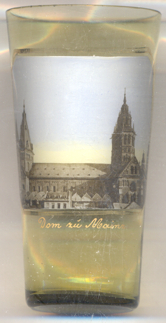

|
| DEUTSCHLAND | GERMANY |
| Bundesland: Rheinland-Pfalz | Rhineland-Palatinate |
| Stadt: Mainz |
Mainz is situated at an elevation of 85 m at the left bank of the Rhine, across the mouth of the Main river. Mainz is the capital of Germany's state of Rheinland-Pfalz and with a population of about 217,100 (2020) also is the state's largest city. Together with the neighbouring Wiesbaden, the capital of Hesse, it forms a metropolitan area with a population of about 500,000.
 The first permanent settlements in this area originated in Celtic times, the second half of the 1st millenium BC.
The Romans arrived here after the Gallic Wars and in 13 or 12 BC founded a military settlement which they called
Mogontiacum. The name was derived from the name of Mogon, a Celtic deity. Mogontiacum became the capital
of the Roman province Germania Superior and for more than 500 years remained part of the Roman empire. During the late
period of the Roman rule the first Christian communities were founded. The first bishop is already documented in 343 AD.
After the period of the Migration of Nations, Mainz developed into a town that became most influential in cultural,
religious and political respect. In 780/782 Mainz obtained the status of an archdiocese. The ecclesiastical province of
Mainz became the largest north of the Alps. The christianization of the east (Saxony) was initiated in the mid-8th century
by archbishop Bonifatius (St. Boniface). The political influence of the archbishops was so great that they rose to the
rank of Archchancellors of the Empire (Reichserzkanzler), Electors of the Holy Roman Empire and sovereign rulers of
the Electorate of Mainz. In 1244 the city of Mainz obtained important privileges from the archbishop and from then on was
had the status of a free city. This freedom ended when the city was conquered in 1462 by Adolf II of Nassau,
archbishop of Mainz.
The first permanent settlements in this area originated in Celtic times, the second half of the 1st millenium BC.
The Romans arrived here after the Gallic Wars and in 13 or 12 BC founded a military settlement which they called
Mogontiacum. The name was derived from the name of Mogon, a Celtic deity. Mogontiacum became the capital
of the Roman province Germania Superior and for more than 500 years remained part of the Roman empire. During the late
period of the Roman rule the first Christian communities were founded. The first bishop is already documented in 343 AD.
After the period of the Migration of Nations, Mainz developed into a town that became most influential in cultural,
religious and political respect. In 780/782 Mainz obtained the status of an archdiocese. The ecclesiastical province of
Mainz became the largest north of the Alps. The christianization of the east (Saxony) was initiated in the mid-8th century
by archbishop Bonifatius (St. Boniface). The political influence of the archbishops was so great that they rose to the
rank of Archchancellors of the Empire (Reichserzkanzler), Electors of the Holy Roman Empire and sovereign rulers of
the Electorate of Mainz. In 1244 the city of Mainz obtained important privileges from the archbishop and from then on was
had the status of a free city. This freedom ended when the city was conquered in 1462 by Adolf II of Nassau,
archbishop of Mainz.
Johannes Gutenberg invented the art of printing in 1450. Although this was of great importance for the Reformation throughout the Holy Roman Empire, the Reformation never really could gain grounds in Mainz. In the early 17th century the town was heavily fortified. Nevertheless it was conquered by Swedish troops during the Thirty Years' War (1618–1648). During the Baroque period the city became a splendid residence town. After the French Revolution the archbishop Friedrich Karl Joseph von Erthal fiercely opposed the new ideas. However, when France had occupied the territories west of the Rhine in 1792, the archbishop had to flee from his town. In 1793 the first free elections led to the Mainz Republic, which, however, lasted for only a few months until the city was reconquered by Prussia. In 1797 the city was occupied again by France. In Germany, the Reichsdeputationshauptschluss of 1803 determined the end of all ecclesiastical states including the Electorate of Mainz, and the city, now being part of France, became the capital of the département du Mont-Tonnerre (Donnersberg).
 After the Congress of Vienna of 1815 the city in 1816 became part of the Grand Duchy of Hesse-Darmstadt.
As it now had lost its role as a residence town, it soon was degraded to a somewhat provincial town.
The archdiocese also was not re-established. Instead, the new diocese of Mainz, which covered only the territory of the Grand
Duchy, was created as a suffragan diocese of the archdiocese of Freiburg. However,
the diocese retained the old honorary title "Holy See" (of Mainz) as the only diocese apart from the
Vatican (or, more precicely, the Pope). The jewish heritage of the city, with the jewish cemetery dating back to
the 11th century was inscribed (together with the jewish sites of Speyer and Worms)
in the UNESCO list of World Cutural heritage sites in 2021.
(see also list of other UNESCO heritage sites depicted on glasses of this collection)
After the Congress of Vienna of 1815 the city in 1816 became part of the Grand Duchy of Hesse-Darmstadt.
As it now had lost its role as a residence town, it soon was degraded to a somewhat provincial town.
The archdiocese also was not re-established. Instead, the new diocese of Mainz, which covered only the territory of the Grand
Duchy, was created as a suffragan diocese of the archdiocese of Freiburg. However,
the diocese retained the old honorary title "Holy See" (of Mainz) as the only diocese apart from the
Vatican (or, more precicely, the Pope). The jewish heritage of the city, with the jewish cemetery dating back to
the 11th century was inscribed (together with the jewish sites of Speyer and Worms)
in the UNESCO list of World Cutural heritage sites in 2021.
(see also list of other UNESCO heritage sites depicted on glasses of this collection)
 The city again began to grow in the late 19th century, the various parts of the fortifications were put down in the
following decades. After World War I, Mainz was again occupied by France until 1930. During World War II,
especially during bomb raids in February 1945, the city was almost completely destroyed. After the war, the Rhine river
marked the boundary between the French and American zones. The suburbs of the city on the right bank of the river were
handed over to the municipal administration of Wiesbaden, which was made permanent after the
foundation of the states of Rheinland-Pfalz and Hessen in the Federal Republic of Germany.
The city again began to grow in the late 19th century, the various parts of the fortifications were put down in the
following decades. After World War I, Mainz was again occupied by France until 1930. During World War II,
especially during bomb raids in February 1945, the city was almost completely destroyed. After the war, the Rhine river
marked the boundary between the French and American zones. The suburbs of the city on the right bank of the river were
handed over to the municipal administration of Wiesbaden, which was made permanent after the
foundation of the states of Rheinland-Pfalz and Hessen in the Federal Republic of Germany.
The famous  cathedral of Mainz [left, no. 1984: bottom left picture, and right,
no. 3596] is the church of the bishops of Mainz. Its patron saint is St. Martin of Tours, the east
choir is dedicated to St. Stephen. The construction began in the late 10th century (975 or 995) in Ottonic style.
This church already exhibited two choirs, two transepts, six towers and three naves. Despite many rebuilding works
throughout the following centuries this basic shape has been preserved until today. The three-naved Romanesque basilica was
extended by Gothic and Baroque additions. Fortunately, the cathedral suffered not too many damages during World War II.
Although the upper level of the cloister was destroyed and most of the roofs of the cathedral burnt down, the structure with
all vaultings remained intact. The restoration works after the war lasted until the 1970's.
cathedral of Mainz [left, no. 1984: bottom left picture, and right,
no. 3596] is the church of the bishops of Mainz. Its patron saint is St. Martin of Tours, the east
choir is dedicated to St. Stephen. The construction began in the late 10th century (975 or 995) in Ottonic style.
This church already exhibited two choirs, two transepts, six towers and three naves. Despite many rebuilding works
throughout the following centuries this basic shape has been preserved until today. The three-naved Romanesque basilica was
extended by Gothic and Baroque additions. Fortunately, the cathedral suffered not too many damages during World War II.
Although the upper level of the cloister was destroyed and most of the roofs of the cathedral burnt down, the structure with
all vaultings remained intact. The restoration works after the war lasted until the 1970's.
The  Kaiserbrücke [left, no. 1984: bottom right picture] was designed by Franz Heinrich Schwechten
and was built in 1902–1904. The truss railroad bridge with it characteristic sandstone porch tower was destroyed in 1945.
A new railroad bridge, the Nordbrücke (North Bridge), was built in its place in 1954–1955.
Kaiserbrücke [left, no. 1984: bottom right picture] was designed by Franz Heinrich Schwechten
and was built in 1902–1904. The truss railroad bridge with it characteristic sandstone porch tower was destroyed in 1945.
A new railroad bridge, the Nordbrücke (North Bridge), was built in its place in 1954–1955.
[https://de.wikipedia.org/wiki/Mainz;
https://de.wikipedia.org/wiki/Mainzer_Dom;
https://de.wikipedia.org/wiki/Kaiserbr%C3%BCcke_(Mainz)]
![[scale]](lineal.jpg)